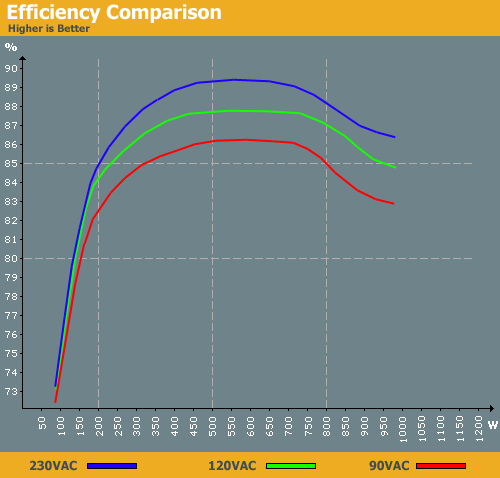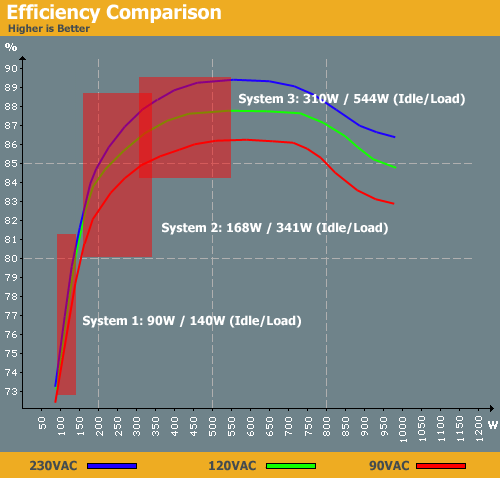Debunking Power Supply Myths
by Christoph Katzer on September 22, 2008 3:00 AM EST- Posted in
- Cases/Cooling/PSUs
Efficiency Explained
All power supplies have a specific efficiency curve, which we show in our reviews. As an example, we will use the Cooler Master UCP 900W power supply. Here is the efficiency curve we measured during testing:

Efficiency is the output power divided by the input power, as there is a certain amount of power lost during the AC to DC conversion. The x-axis shows the power supply load in Watts and the y-axis shows efficiency. Let's include our three sample systems in the chart see what sort of efficiency they would get with this power supply.

The first system causes this high-performance power supply to only run at 73% to 81% efficiency, depending on input voltage. Obviously, there's absolutely no need for a 900W power supply if you're running this type of computer.
The midrange system looks quite a bit better, allowing the PSU to run at 80% to 88% efficiency, although the latter only occurs at maximum load. Considering the vast majority of systems rarely run at 100% load most of the time, real-world efficiency will average closer to 82%. Office work and Internet surfing in particular will be at that level.
For the third system, a 900W power supply actually might start to make sense. It's still more than you need, but having a bit of extra room to grow isn't a bad idea. This system idles at over 300W, so it achieves a minimum 86% efficiency with 120VAC. When running a game or other demanding task, the PSU is finally able to reach its potential and provide 89% efficiency with 230VAC (or 87.5% with 120VAC).
The quick summary then is that if you don't have a system that uses 350W of power when idle, it's probably not worthwhile to purchase this type of power supply. Our high-end sample system more or less meets this qualification, and if you were to take such a system and overclock it, these high-end power supplies are actually required. The 8800 Ultra is one of the most demanding graphics cards currently available; however, the GTX 280 appears to require even more power, making that another candidate for this sort of PSU. (Unfortunately, our power supply testing labs didn't have the latest GPUs available for testing.)










98 Comments
View All Comments
nilepez - Thursday, September 25, 2008 - link
I've seen this site and countless others constantly promoting the benefit of 750 watt+ PSUs.The reality is virtually nobody needs 500W, much less 750 or 1KW.
AnAverageJoe - Wednesday, September 24, 2008 - link
Thank you for this article, it is really one of the more organized efforts at getting this kind of info out there that I have read and hopefully will save folks from overdoing it (saving $$ in the process). Couple of comments:1. p.1 “If people really took the time to examine system power requirements”: From the perspective of building a new rig, where does one find this information? Any sort of figures, short of the very few articles such as this and public power supply guesstimators, appear non-existent. As stated in the article something is better than nothing but getting precise information appears impossible for any given component. Both Intel and AMD publicly provide technical data on their parts but the only single figure one can really get out of that data is the TDP for the processors. I have failed to find any similar technical data for GPUs and although most graphics card reviews now include power draw it is for the system and not the graphics card itself thus there is is no way to get the discrete graphics card power draw. Ditto for every other component. In sum, I don't see any way for one to gather the required data to compute the power requirements for any planned build short of actually building the thing and putting test equipment to it.
2. I was left wanting a statement to the effect of "one important goal of choosing a power supply is to maximize efficiency under expected operating loads." The examples do make the point just took a bit longer for me to get it thru my dense skull.
Again, thanks for spending the time to put this together because this really is I think one of the most overlooked areas of system integration and in my experience impossible to more than generally guesstimate.
Cincybeck - Tuesday, September 30, 2008 - link
Try searching "power supply calculator" in Google. The one, eXtreme has, provides a pretty complete list and quite a bit of options. I punched in the low end and mid range computers from the article. The calculator is high according to the article's results, but close enough to give you a good idea.Johnniewalker - Wednesday, September 24, 2008 - link
I have been waiting for an article like this for years, thanks! I always suspected people were buying PSU's that were too big.rvikul - Tuesday, September 23, 2008 - link
Anandtech is back! This is exactly the kind of information Anandtech excels at providing. very relevant and very useful. Thanks and keep it up (and please dont go back to discussing social issues etc).OddJensen - Wednesday, September 24, 2008 - link
Strange figure for the 2900XT. Knowing it's one of the most powerguzzling single GPU cards, it should have been much higher, right?CSMR - Tuesday, September 23, 2008 - link
I'm going to repeat myself because I feel this is important.The tables claim to represent actual power consumption of processors and chipsets but the figures are very exaggerated. (There are even people who run whole systems on one or two of the chipsets listed on less power than the power the article claims for just the chipset.)
Here are more accurate CPU measurements from xbitlabs:
http://www.xbitlabs.com/articles/cpu/display/intel...">http://www.xbitlabs.com/articles/cpu/display/intel...
Behardware gets similar results. (Can't find the link straight away.)
Must fix this as Anand needs to keep its reputation for good information. You can't have figures (CPU idle power) that are out by a factor of 10!
The graphics idle power data are better than the CPU data but also too high, by a factor of about 2, compared to existing measurements:
http://archive.atomicmpc.com.au/forums.asp?s=2&...">http://archive.atomicmpc.com.au/forums.asp?s=2&...
JarredWalton - Tuesday, September 23, 2008 - link
The question is: did Christoph measure power incorrectly, or did someone else? From my understanding, he's measuring the current on the various wires leading from the PSU to the components. HDD is of course easy to measure. The ATX12V/EPS12V connector supplies the CPU, so that's simple as well. PCI-E gets 12V from the PEG connector along with the extra four pins on the 24-pin ATX connector. The remaining pins on the 24-pin ATX feed the chipset, RAM, and other motherboard components. Sum all of that together and you get the power draw for the entire system.Perhaps the CPU power draw numbers are high and the chipset/mobo numbers are low, but worst case the point of the article is to show that higher wattage PSUs are not required for most systems. A midrange system with similar components might use a bit less than what we estimate, but I'm quite sure it wouldn't need more power than our high estimate.
I won't guarantee that the individual numbers are 100% accurate, but I doubt that desktop C2D processors are idle at only 7W or less. I know on my own C2Q Q6600 8800GT 4GB system it idles at 176W power draw, and if I put a load on just the CPU (Folding@Home SMP) the draw increases to 262W. Guessing at 80% efficiency, the components are consuming 141W to 210W, which means CPU (and mobo, chipset, and RAM) power use went up 69W. That's pretty close to the QX6850 result (fudging on the 65nm vs. 45nm and Penryn vs. Kentsfield). The Fur benchmark also gives ~262W average (one core is 100% load on the CPU), so the GPU + one CPU core increases power consumption by the same 69W, but some of it goes to the CPU and most of it goes to the GPU. That jives with the 51W increase in power Christoph measured on the 8800 GT. Running both - a "worst case" test - gives a power draw of 315W to 337W, with an average of around 324W.
So a system somewhat similar to Christoph's "midrange" setup (and estimating efficiency) uses 141W idle and 260W load. That doesn't include trying to tax the HDD or DVD, which might increase the load by another 20W, and it uses a single GPU instead of a 3870X2. What's the specific amount used by the CPU, the GPU, the RAM, the chipset, and the other motherboard components? I can only guesstimate, but stepping back to examine the whole picture I don't have any serious problems with the tables on page 1. CPU power is probably lower, since it sounds like Christoph measured the current going through the ATX12V lines and some of that will feed the VRMs and other bits and pieces on the motherboard.
Christoph Katzer - Wednesday, September 24, 2008 - link
Thanks for the explanation. The point being is that I measured how much current is going to the CPU through the 12V rails. What happens later doesn't matter since the power supply needs to deliver X current at that specific time.That doesn't mean however that the CPU is actually using all of this delivered power since we loose power at the VRMs and CPU itself. SO if there is X watts going to the CPU it doesn't mean the CPU actually needs that much power but since it is being delivered it should be called the "actual power consumption".
For example the 6000+ which needs quite too much obviously. We know now it had something to do with the different VRMs at the AM2 and AM2+ boards. The power is being delivered, meaning the power supply needs to provide this amount x. If the CPU actually needs it or not is irrelevant. Of course if I would have known from the difference between AM2 and AM2+ I would have measured it in a different way, no one is perfect and I know now how to do it better next time.
As for the Chipset it is indeed tricky since every mobo vendor has different additional chips installed that take a different amount of power. So if we do publish an article about this we will have to mention the actual manufacturer of course.
It's just funny that everyone says the results are too high but I get an Email from Taipei that my numbers are far too low...
Barack Obama - Tuesday, September 23, 2008 - link
Notch one up for the great AT team :D